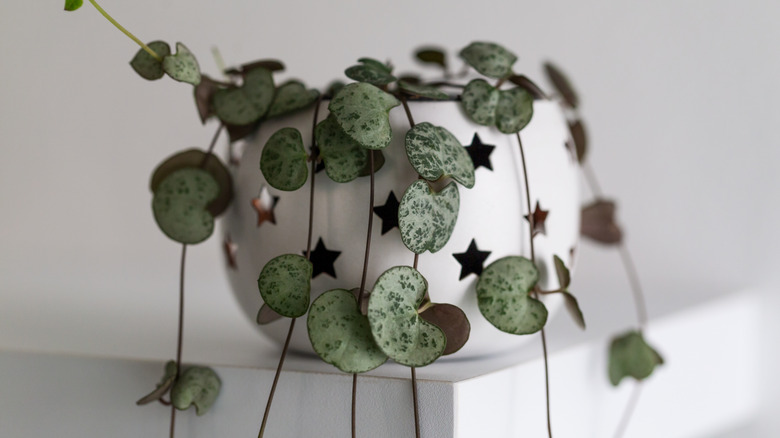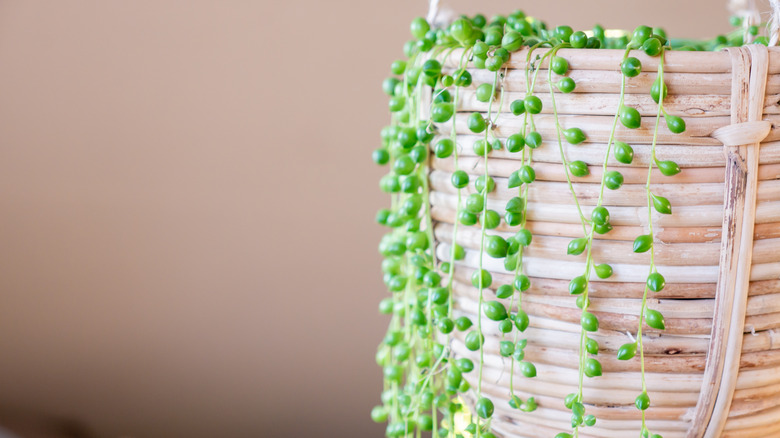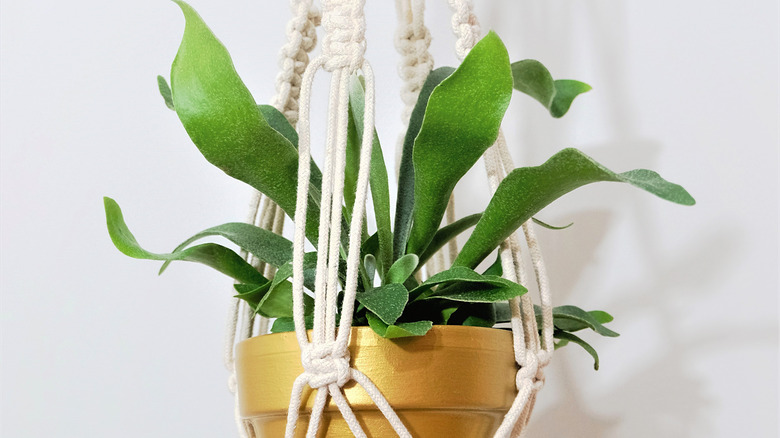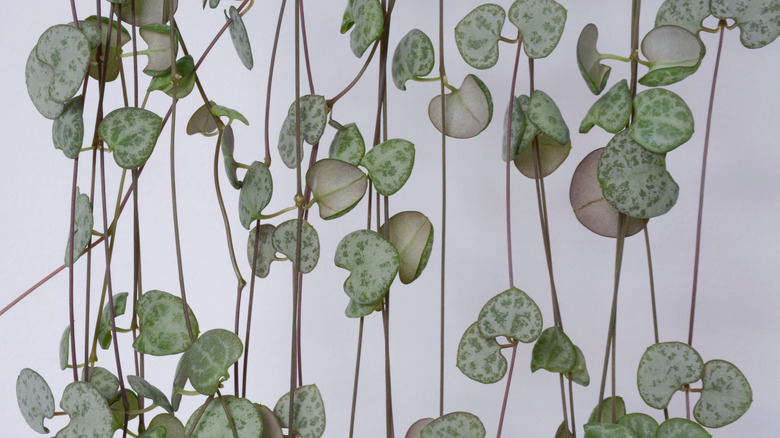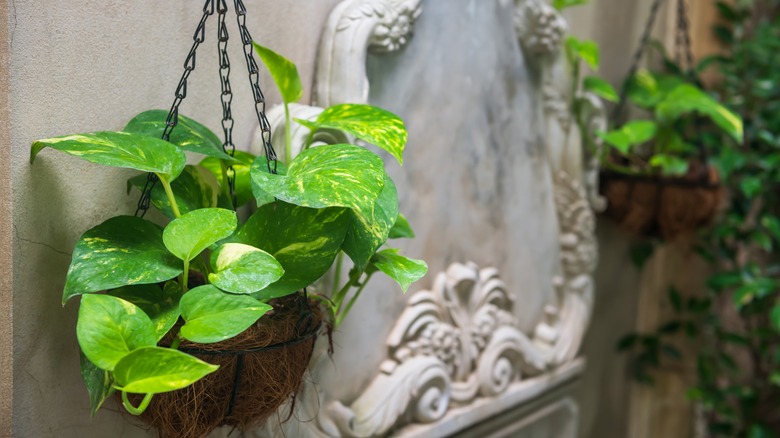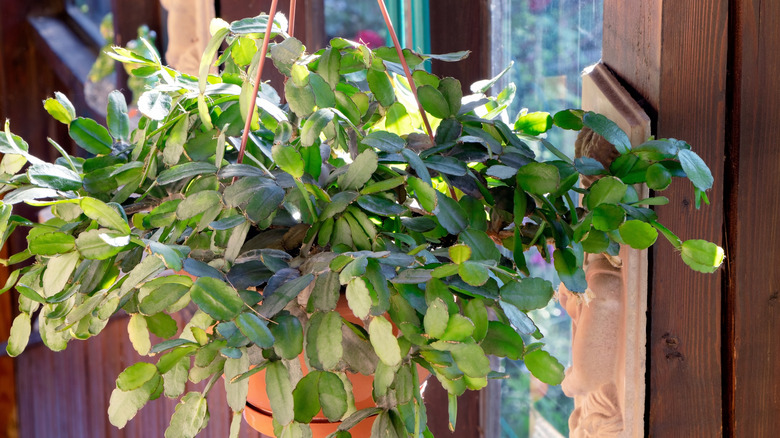The 5 Best Trailing Houseplants For Your Sunny Window
Most houseplants come from tropical or arid regions, states ESP, which is why when you shop, so many tags say they do best in homes with bright, indirect sunlight. If you are fortunate enough to have a sunny window in your home, many beautiful and unique trailing plants would be happy to live in that spot.
Enthusiasts might say that you can never have too many houseplants, and who are we to argue? Not only are plants pretty, but they also offer a number of mental and physical health benefits. Simply caring for your indoor plants helps produce peaceful feelings, according to Healthline. Living greenery in the home may also improve air quality by removing harmful airborne chemicals called Volatile Organic Compounds (VOCs). And, of course, they turn carbon dioxide into oxygen. If you want to add some new plants to your collection, here are a few trailing plants that thrive in a sunny window.
1. String of pearls
The string of pearls plant (Senecio rowleyanus) makes a wonderful, unique trailing houseplant. This succulent lives up to its name, offering long vines with tiny round pearl-like buds. They like warm conditions, so being close to a sunny window gives them the bright light and extra heat they need to grow and thrive indoors. According to Succulents Box, this plant needs at least six hours of sunlight a day, so in the shorter winter months, supplementing with a grow light might help them continue developing through the winter.
The string of pearls plant does not have any special humidity requirements. In fact, since they grow naturally in a dry environment, the humidity in the average home of about 40% is sufficient. They do not like soggy roots, so select a planting medium and planter that drains well. You can find special soil for succulents and cacti at most garden centers. Only water this plant when the soil is dry, half an inch below the soil line, or about every two weeks.
2. Staghorn fern
Staghorn ferns (Platycerium bifurcatum) produce large fronds that resemble elk horns at maturity, states The Good Earth Garden Center. Staghorn ferns are epiphytes — plants that grow on other plants, trees, or structures. They are not parasitic and do not harm their structural host while absorbing water and nutrients from the surrounding environment. Because this plant can absorb water efficiently through its roots and fronds, staghorn ferns can be grown in a pot or mounted to a piece of wood with burlap and moss to support its roots. This plant is literally a work of living art.
Staghorn ferns love the bright, indirect light a sunny window offers. Although they thrive in a humid environment, regular misting will help them stay healthy in a home with average humidity. These ferns like moist but not soggy soil, so water whenever the soil surface feels dehydrated. Staghorn ferns will wilt when the soil is too dry, so watch your plant for signs of stress and adjust your watering schedule accordingly.
3. String of hearts
Originally from South Africa, the string of hearts (Ceropegia woodii) is a beautiful trailing plant with intricately patterned leaves and purple stems. The Wisconsin Horticulture Division of Extension states this plant offers the showiest colors when hanging in front of a sunny window and may even bloom occasionally with intricate, vase-like flowers. When placed outdoors in a shady spot in spring and summer, these unique blooms are a favorite of hummingbirds.
The string of hearts is the most common name for this trailing plant, but it is also referred to as rosary vine and bushman's pipevine. Although it does not look like a succulent, the string of hearts is part of that family, so like the string of pearls, it benefits from a succulent planting medium in a pot that provides good drainage. This low-maintenance plant does not have fertilization or humidity requirements and should only be watered when the soil is dry.
4. Pothos
When it comes to easy-to-grow houseplants, the pothos plant (Epipremnum aureum) is at the top of the list, and there are several varieties from which to choose. Golden pothos is a classic with its yellow variegation. This common type is available almost anywhere that sells plants and is a staple in doctor's offices and restaurants. Neon and Snow Queen are just a few other favorites of pothos growers. While the leaves may have slightly different shapes and hues, according to Ohio Tropics, one thing is the same: you will get the most color and variegation in plants that have access to bright, indirect sunlight. Any kind of pothos is perfect for the beginning grower with access to a sunny window.
One of the best things about growing pothos is that they can tolerate some neglect. They don't like soggy soil, so let your plant dry out between waterings. Give it some water if it starts to wilt, and it will perk back up. They also like to be slightly root-bound, so when selecting a planter, choose one that is the same size or one size larger than the nursery pot.
5. Christmas cactus
The Christmas cactus (Schlumbergera truncata) is similar to the staghorn fern in that it is also an epiphyte accustomed to living above the ground in the humid forests of Brazil. These beautiful plants are so hardy and low-maintenance; some consider them heirloom plants because they can live up to 100 years, states Garden Betty. While the plant is a beautiful addition to any space with its interesting texture and gently lobed leaves, what people love about Schlumbergera truncate is its blooms. Depending on the variety, a Christmas cactus will reward you with stunning pink, red, or even apricot-colored flowers in the right conditions.
While they have "cactus" in their name, they are not native to arid environments, preferring warm, humid conditions with bright, indirect light. These plants consistently prefer moist soil in a container with good drainage. To get those desired blooms on your Christmas cactus, mimic natural conditions by reducing the temperature in their space to around 60 degrees Fahrenheit. Allow them to live in low-light conditions during the short winter days and let the soil dry between waterings when the buds begin to form.
